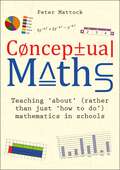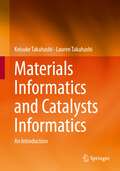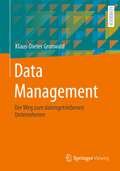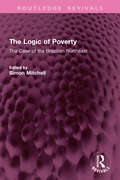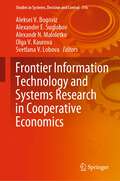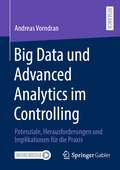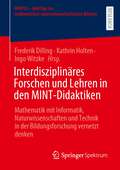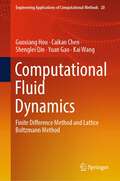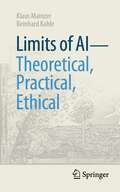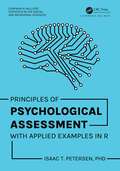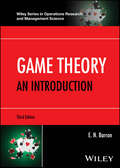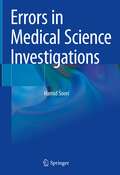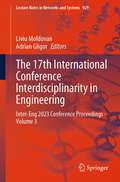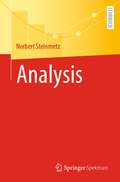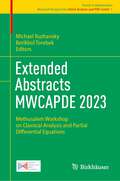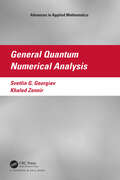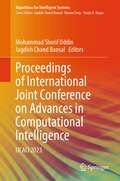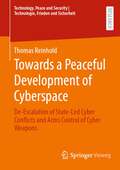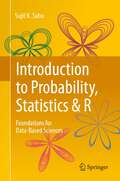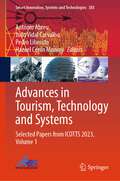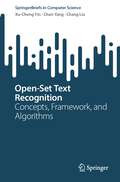- Table View
- List View
Conceptual Maths: Teaching 'about' (rather than just 'how to do') mathematics in schools
by Peter MattockWritten by Peter Mattock, Conceptual Maths: Teaching 'about' (rather than just 'how to do') mathematics in schoolsaims to empower teachers to support students on a comprehensive and coherent journey through school mathematics. Showcasing the best models, metaphors and representations, it provides excellent examples, explanations and exercises that can be used across the curriculum. Concepts are at the heart of the study of mathematics. They are the ideas that remain constant whenever they are encountered, but which combine and build upon each other to create the mathematical universe. It is the structure of each concept that gives rise to the procedures that are used in calculation and problem-solving - and, by learning about these structures, a learner can make sense of how different processes work and use them flexibly as need demands. In his first book,Visible Maths, Peter Mattock focused on the use of representations and manipulatives as images and tools and how this can provide a window into some of these mathematical structures. His aim in Conceptual Mathsis to go deeper, beyond the procedures, and to shed greater light on the structures of the subject's different concepts. The book explores how a variety of visual tools and techniques can be used in the classroom to deepen pupils' understanding of mathematical structures, concepts and operations, including: number; addition and subtraction; multiplication and multiples; division and factors; proportionality; functionality; measures; accuracy; probability; shape and transformation; and vectors, among many others. In so doing, Peter equips teachers with the confidence and practical know-how to help learners assimilate knowledge of mathematical concepts into their schema and take their learning to the next level. Containing numerous full-colour diagrams and models to illustrate the conceptual takeaways and teaching techniques discussed, Conceptual Mathsalso includes a glossary covering the key mathematical terms. Suitable for teachers of maths in primary, secondary and post-16 settings
Materials Informatics and Catalysts Informatics: An Introduction
by Keisuke Takahashi Lauren TakahashiThis textbook is designed for students and researchers who are interested in materials and catalysts informatics with little to no prior experience in data science or programming languages. Starting with a comprehensive overview of the concept and historical context of materials and catalysts informatics, it serves as a guide for establishing a robust materials informatics environment. This essential resource is designed to teach vital skills and techniques required for conducting informatics-driven research, including the intersection of hardware, software, programming, machine learning within the field of data science and informatics. Readers will explore fundamental programming techniques, with a specific focus on Python, a versatile and widely-used language in the field. The textbook explores various machine learning techniques, equipping learners with the knowledge to harness the power of data science effectively. The textbook provides Python code examples, demonstrating materials informatics applications, and offers a deeper understanding through real-world case studies using materials and catalysts data. This practical exposure ensures readers are fully prepared to embark on their informatics-driven research endeavors upon completing the textbook. Instructors will also find immense value in this resource, as it consolidates the skills and information required for materials informatics into one comprehensive repository. This streamlines the course development process, significantly reducing the time spent on creating course material. Instructors can leverage this solid foundation to craft engaging and informative lecture content, making the teaching process more efficient and effective.
Data Management: Der Weg zum datengetriebenen Unternehmen
by Klaus-Dieter GronwaldDieses Lehrbuch betrachtet Data Management als interdisziplinäres Konzept mit Fokus auf den Zielen datengetriebener Unternehmen. Im Zentrum steht die interaktive Entwicklung eines Unternehmensdatenmodells für ein virtuelles Unternehmen mit Unterstützung eines online Learning Games unter Einbeziehung der Aufgaben, Ziele und Grundsätze des Data Managements, typischer Data-Management-Komponenten und Frameworks wie Datenmodellierung und Design, Metadaten Management, Data Architecture, und Data Governance, und verknüpft diese mit datengetriebenen Anwendungen wie Business Warehousing, Big Data, In-Memory Data Management, und Machine Learning im Data Management Kontext.Das Buch dient als Lehrbuch für Studierende der Informatik, der Wirtschaft und der Wirtschaftsinformatik an Universitäten, Hochschulen und Fachschulen und zur industriellen Aus- und Weiterbildung.
The Logic of Poverty: The Case of the Brazilian Northeast (Routledge Revivals)
First published in 1981, The Logic of Poverty consists of eight essays that share at least one assumption: that Northeast Brazil provides a startling example of inhumane economic development. The contributors have all worked in the area, and know it at first hand. They look at rural structure and the role of the unemployed ‘reserve army’, the state of the sugar industry, the ineffectiveness of the irrigation schemes, the stagnation in the fishing sector, the lack of credit available to peasants and the role of SUDENE, the first development agency in the region. Together they paint a picture of poverty and of the factors that allow it to continue, and they place that poverty in the context of the wider economy of Brazil, relating it to the extraordinary transformation that has been called ‘the Brazilian miracle’. This book will be of interest to students of geography, anthropology, economics and sociology.
The Logic of Poverty: The Case of the Brazilian Northeast (Routledge Revivals)
by Simon MitchellFirst published in 1981, The Logic of Poverty consists of eight essays that share at least one assumption: that Northeast Brazil provides a startling example of inhumane economic development. The contributors have all worked in the area, and know it at first hand. They look at rural structure and the role of the unemployed ‘reserve army’, the state of the sugar industry, the ineffectiveness of the irrigation schemes, the stagnation in the fishing sector, the lack of credit available to peasants and the role of SUDENE, the first development agency in the region. Together they paint a picture of poverty and of the factors that allow it to continue, and they place that poverty in the context of the wider economy of Brazil, relating it to the extraordinary transformation that has been called ‘the Brazilian miracle’. This book will be of interest to students of geography, anthropology, economics and sociology.
Frontier Information Technology and Systems Research in Cooperative Economics (Studies in Systems, Decision and Control #316)
by Aleksei V. Bogoviz Alexander E. Suglobov Alexandr N. Maloletko Olga V. Kaurova Svetlana V. LobovaThis book is the very first book-length study devoted to the advances in technological development and systems research in cooperative economics. The chapters provide, first of all, a coherent framework for understanding and applying the concepts and approaches of complexity and systems science for the advanced study of cooperative networks and particular cooperative enterprises and communities. Second, the book serves as a unique source of reliable information on the frontier information technologies available for the production, consumer, credit, and agricultural cooperative enterprises, discussing predominant strategies, potential drivers of change, and responses to complex problems. Given the diverse range of backgrounds and advanced research results, researchers, decision-makers, and stakeholders from all fields of cooperative economics in any country of the world will undoubtedly benefit from this book.
Big Data und Advanced Analytics im Controlling: Potenziale, Herausforderungen und Implikationen für die Praxis
by Andreas VorndranDie Digitalisierung und Entwicklungen im Gebiet der künstlichen Intelligenz haben in den letzten Jahren erhebliche Veränderungen in der Gesellschaft und der Unternehmenspraxis hervorgerufen. Aufkommende Technologien in den Feldern Big Data und Advanced Analytics werden auch im Controlling zunehmend diskutiert oder bereits eingesetzt. Dabei befinden sich der Wissensstand, inwieweit Big Data und Advanced Analytics das Controlling beeinflussen und verändern können, und die praktische Anwendung noch in einem frühen Stadium. Diese Arbeit befasst sich deshalb mit der Untersuchung der möglichen Auswirkungen von Big Data und Advanced Analytics im Controlling. Vor diesem Hintergrund werden die Einflüsse dieser digitalen Trends auf den Informationsversorgungsprozess des Controllings, auf die Erfüllung Controlling-spezifischer Anforderungen an Informationen und auf das Forecasting, die Budgetierung und die strategische Planung analysiert. Ferner werden praxisrelevante Herausforderungen, Grenzen und Risiken bei der Implementierung und Nutzung identifiziert sowie Implikationen zu deren Umgang zur Ausschöpfung der Potenziale abgeleitet.
Interdisziplinäres Forschen und Lehren in den MINT-Didaktiken: Mathematik mit Informatik, Naturwissenschaften und Technik in der Bildungsforschung vernetzt denken (MINTUS – Beiträge zur mathematisch-naturwissenschaftlichen Bildung)
by Frederik Dilling Kathrin Holten Ingo WitzkeFachübergreifender und fächerverbindender Unterricht in den MINT-Fächern (Mathematik, Informatik, Naturwissenschaften & Technik) werden seit Langem in Forschung und Bildungspolitik gefordert, aber selten in der unterrichtlichen Praxis umgesetzt. Um einen solchen Unterricht in der Schule zu fördern, ist es wichtig, die aus den MINT-Fachdidaktiken heraus gemeinsam entwickelten Konzepte zugänglich zu machen und Inhaltsfelder mehrperspektivisch zu erschließen.Der vorliegende Band stellt unterschiedliche interdisziplinäre Vorhaben aus den Bereichen Bildungsforschung, Lehrer*innenbildung und Unterrichtsentwicklung mit einem Fokus auf Mathematik vor.
Computational Fluid Dynamics: Finite Difference Method and Lattice Boltzmann Method (Engineering Applications of Computational Methods #20)
by Guoxiang Hou Caikan Chen Shenglei Qin Yuan Gao Kai WangThis book provides a concise and comprehensive introduction to several basic methods with more attention to their theoretical basis and applications in fluid dynamics. Furthermore, some new ideas are presented in this book, for example, a method to solve the transition matrix by difference operator transformation. For this method, the book gives the definition of Fourier integral transformation of translation operator, and proves the transition matrix equaling to the differential operator transformation, so that it is extended to general situations of explicit, implicit, multi-layer difference equations, etc. This flexible approach is also used in the differential part. In addition, the book also includes six types of equivalent stability definitions in two ways and deeply analyzes their errors, stabilities and convergences of the difference equations. What is more important, some new scientific contributions on lattice Boltzmann method (LBM) in recent years are presented in the book as well. The authors write the book combining their ten years teaching experience and research results and this book is intended for graduate students who are interested in the area of computational fluid dynamics (CFD). Authors list some new research achievements, such as simplified lattice Boltzmann method, the simplified lattice Boltzmann flux solver and discrete unified gas kinetic scheme, and expect that this new information could give readers possible further investigating ideas in their future research on CFD area.
Limits of AI - theoretical, practical, ethical (Technik im Fokus)
by Klaus Mainzer Reinhard KahleArtificial intelligence is a key technology with great expectations in science, industry, and everyday life. This book discusses both the perspectives and the limitations of this technology. This concerns the practical, theoretical, and conceptual challenges that AI has to face. In an early phase of symbolic AI, AI focused on formal programs (e.g., expert systems), in which rule-based knowledge was processed with the help of symbolic logic. Today, AI is dominated by statistics-based machine learning methods and Big Data. While this sub-symbolic AI is extremely successful (e.g., chatbots like ChatGPT), it is often not transparent. The book argues for explainable and reliable AI, in which the logical and mathematical foundations of AI-algorithms become understandable and verifiable.
Principles of Psychological Assessment: With Applied Examples in R (Chapman & Hall/CRC Statistics in the Social and Behavioral Sciences)
by Isaac T. PetersenThis book highlights the principles of psychological assessment to help researchers and clinicians better develop, evaluate, administer, score, integrate, and interpret psychological assessments. It discusses psychometrics (reliability and validity), the assessment of various psychological domains (behavior, personality, intellectual functioning), various measurement methods (e.g., questionnaires, observations, interviews, biopsychological assessments, performance-based assessments), and emerging analytical frameworks to evaluate and improve assessment including: generalizability theory, structural equation modeling, item response theory, and signal detection theory. The text also discusses ethics, test bias, and cultural and individual diversity.Key Features Gives analysis examples using free software Helps readers apply principles to research and practice Provides text, analysis code/syntax, R output, figures, and interpretations integrated to guide readers Uses the freely available petersenlab package for R Principles of Psychological Assessment: With Applied Examples in R is intended for use by graduate students, faculty, researchers, and practicing psychologists.
Principles of Psychological Assessment: With Applied Examples in R (Chapman & Hall/CRC Statistics in the Social and Behavioral Sciences)
by Isaac T. PetersenThis book highlights the principles of psychological assessment to help researchers and clinicians better develop, evaluate, administer, score, integrate, and interpret psychological assessments. It discusses psychometrics (reliability and validity), the assessment of various psychological domains (behavior, personality, intellectual functioning), various measurement methods (e.g., questionnaires, observations, interviews, biopsychological assessments, performance-based assessments), and emerging analytical frameworks to evaluate and improve assessment including: generalizability theory, structural equation modeling, item response theory, and signal detection theory. The text also discusses ethics, test bias, and cultural and individual diversity.Key Features Gives analysis examples using free software Helps readers apply principles to research and practice Provides text, analysis code/syntax, R output, figures, and interpretations integrated to guide readers Uses the freely available petersenlab package for R Principles of Psychological Assessment: With Applied Examples in R is intended for use by graduate students, faculty, researchers, and practicing psychologists.
Mastering NLP from Foundations to LLMs: Apply advanced rule-based techniques to LLMs and solve real-world business problems using Python
by Lior Gazit Meysam GhaffariEnhance your NLP proficiency with modern frameworks like LangChain, explore mathematical foundations and code samples, and gain expert insights into current and future trends Key FeaturesLearn how to build Python-driven solutions with a focus on NLP, LLMs, RAGs, and GPTMaster embedding techniques and machine learning principles for real-world applicationsUnderstand the mathematical foundations of NLP and deep learning designsPurchase of the print or Kindle book includes a free PDF eBookBook DescriptionDo you want to master Natural Language Processing (NLP) but don’t know where to begin? This book will give you the right head start. Written by leaders in machine learning and NLP, Mastering NLP from Foundations to LLMs provides an in-depth introduction to techniques. Starting with the mathematical foundations of machine learning (ML), you’ll gradually progress to advanced NLP applications such as large language models (LLMs) and AI applications. You’ll get to grips with linear algebra, optimization, probability, and statistics, which are essential for understanding and implementing machine learning and NLP algorithms. You’ll also explore general machine learning techniques and find out how they relate to NLP. Next, you’ll learn how to preprocess text data, explore methods for cleaning and preparing text for analysis, and understand how to do text classification. You’ll get all of this and more along with complete Python code samples. By the end of the book, the advanced topics of LLMs’ theory, design, and applications will be discussed along with the future trends in NLP, which will feature expert opinions. You’ll also get to strengthen your practical skills by working on sample real-world NLP business problems and solutions.What you will learnMaster the mathematical foundations of machine learning and NLP Implement advanced techniques for preprocessing text data and analysis Design ML-NLP systems in PythonModel and classify text using traditional machine learning and deep learning methodsUnderstand the theory and design of LLMs and their implementation for various applications in AIExplore NLP insights, trends, and expert opinions on its future direction and potentialWho this book is forThis book is for deep learning and machine learning researchers, NLP practitioners, ML/NLP educators, and STEM students. Professionals working with text data as part of their projects will also find plenty of useful information in this book. Beginner-level familiarity with machine learning and a basic working knowledge of Python will help you get the best out of this book.
Game Theory: An Introduction (Wiley Series in Operations Research and Management Science)
by E. N. BarronAuthoritative and quantitative approach to modern game theory with applications from areas including economics, political science, computer science, and engineering Game Theory acknowledges the role of mathematics in making logical and advantageous decisions in adversarial situations and provides a balanced treatment of the subject that is both conceptual and applied. This newly updated and revised Third Edition streamlines the text to introduce readers to the basic theories behind games in a less technical but still mathematically rigorous way, with many new real-world examples from various fields of study, including economics, political science, military science, finance, biological science, and general game playing. The text introduces topics like repeated games, Bayesian equilibria, signaling games, bargaining games, evolutionary stable strategies, extensive games, and network and congestion games, which will be of interest across a wide range of disciplines. Separate sections in each chapter illustrate the use of Mathematica and Gambit software to create, analyze, and implement effective decision-making models. A companion website contains the related Mathematica and Gambit data sets and code. Solutions, hints, and methods used to solve most problems to enable self-learning are in an Appendix. Game Theory includes detailed information on: The von Neumann Minimax Theorem and methods for solving any 2-person zero sum matrix game. Two-person nonzero sum games solved for a Nash Equilibrium using nonlinear programming software or a calculus method. Nash Equilibria and Correlated Equilibria. Repeated games and punishment strategies to enforce cooperation Games in Extensive Form for solving Bayesian and perfect information games using Gambit. N-Person nonzero sum games, games with a continuum of strategies and many models in economics applications, duels, auctions, of Nash Equilibria, and the Stable Matching problem Coalitions and characteristic functions of cooperative games, an exact nucleolus for three-player games, bargaining Game theory in evolutionary processes and population games A trusted and proven guide for students of mathematics, engineering, and economics, the Third Edition of Game Theory is also an excellent resource for researchers and practitioners in economics, finance, engineering, operations research, statistics, and computer science.
Errors in Medical Science Investigations
by Hamid SooriThis book introduces all common errors in medical science fields and the ways to control them. Systematic errors could be controlled both during study design and statistical analysis. Some errors have been presented in small segments but not in a comprehensive book. It covers many common errors that usually affect the research proposals, final reports, theses, and scientific presentations in the field of medical sciences as well as the rejection reasons on scientific papers. It will help researchers to control common errors using epidemiological and statistical methods.
The 17th International Conference Interdisciplinarity in Engineering: Inter-Eng 2023 Conference Proceedings - Volume 3 (Lecture Notes in Networks and Systems #929)
by Liviu Moldovan Adrian GligorThis book contains research papers that were accepted for presentation at the 17th International Conference on Interdisciplinarity in Engineering—INTER-ENG 2023, which was held on 5–6 October 2023, in the city of Târgu Mureș, Romania. The general scope of the conference “Towards transition for a more competitive European industry in a smart, safe and sustainable future” is proposing a new approach related to the development of a new generation of smart factories grounded on the manufacturing and assembly process digitalization. It is related to advance manufacturing technology, lean manufacturing, sustainable manufacturing, additive manufacturing, manufacturing tools and equipment. It is a leading international professional and scientific forum of great interest for engineers and scientists who can read in this book research works contributions and recent developments as well as current practices in advanced fields of engineering.
Analysis
by Norbert SteinmetzDas Buch wendet sich sowohl an Studierende aller mathematischen Fachrichtungen und mathematisch interessierte Studierende der Physik als auch an Dozentinnen und Dozenten, die den Aufbau ihres ersten Analysiskurses noch vor sich haben oder Anregungen für ihre Vorlesungen suchen. Inhalt und Form sind entstanden und vielfach erprobt in immer wieder kritisch veränderten und angepassten 3-semestrigen Analysiskursen. Etwa 2/3 des Buches decken die Erfordernisse einer 2-semestrigen Grundvorlesung Analysis ab, wohingegen das restliche Drittel Elemente der Fourieranalysis, der Differentialgeometrie, der gewöhnlichen Differentialgleichungen und der Funktionentheorie behandeln, Themen, denen eigenständige Vorlesungen auch weiterhin zu wünschen sind. Zu den Besonderheiten zählen die parallele und miteinander verzahnte Einführung des Riemann- und Lebesgueintegrals, die Einbettung einfacher Elemente der komplexen in die reelle Analysis, ausgedehnte Anwendungen – von der Heisenbergschen Unschärferelation über die Lösung der Wärmeleitungsgleichung bis hin zur Black-Scholes-Formel – sowie die Darstellung der Methode von Ostrogradski und des Dixon-Beweises der allgemeinen Cauchyschen Integralformel. Dass an verschiedenen Stellen die eingefahrenen Pfade verlassen wurden, wird der kundigen Leserschaft nicht verborgen bleiben. Die Frage „abstrakt oder anschaulich-verständlich“ wird konsequent zugunsten des letzteren entschieden. Die Übungsaufgaben sind in den laufenden Text eingebaut in der Hoffnung, dass sie so mehr Beachtung finden. Schließlich vermitteln die historischen Anmerkungen und Kurzbiographien einen Eindruck davon, wie die Analysis sich entwickelt hat und wer wesentlich an dieser Entwicklung beteiligt war.
Extended Abstracts MWCAPDE 2023: Methusalem Workshop on Classical Analysis and Partial Differential Equations (Trends in Mathematics #1)
by Michael Ruzhansky Berikbol TorebekThis collection consists of selected scientific results stemming from the conference "Methusalem Workshop on Classical Analysis and PDEs", held at the Ghent University from 27th February 2023 to 1st March 2023. The workshop was organized by the "Ghent Analysis & PDE Center". The presented materials mainly consist of scientific results on classical analysis and problems of PDEs. In particular, results on harmonic analysis, functional spaces, functional inequalities, inverse problems, non-local PDEs, non-classical problems of PDEs, integro-differential equations, hypoelliptic operators, pseudo-differential calculus, and others are given.
General Quantum Numerical Analysis (ISSN)
by Svetlin G. Georgiev Khaled ZennirThis book is focused on the qualitative theory of general quantum calculus, the modern name for the investigation of calculus without limits. It centers on designing, analysing and applying computational techniques for general quantum differential equations. The quantum calculus or q-calculus began with F.H. Jackson in the early twentieth century, but this kind of calculus had already been worked out by Euler and Jacobi. Recently, it has aroused interest due to high demand of mathematics that models quantum computing and the connection between mathematics and physics.Quantum calculus has many applications in different mathematical areas such as number theory, combinatorics, orthogonal polynomials, basic hyper-geometric functions and other sciences such as quantum theory, mechanics and the theory of relativity.The authors summarize the most recent contributions in this area. General Quantum Numerical Analysis is intended for senior undergraduate students and beginning graduate students of engineering and science courses. The twelve chapters in this book are pedagogically organized, each concluding with a section of practical problems.
General Quantum Numerical Analysis (ISSN)
by Svetlin G. Georgiev Khaled ZennirThis book is focused on the qualitative theory of general quantum calculus, the modern name for the investigation of calculus without limits. It centers on designing, analysing and applying computational techniques for general quantum differential equations. The quantum calculus or q-calculus began with F.H. Jackson in the early twentieth century, but this kind of calculus had already been worked out by Euler and Jacobi. Recently, it has aroused interest due to high demand of mathematics that models quantum computing and the connection between mathematics and physics.Quantum calculus has many applications in different mathematical areas such as number theory, combinatorics, orthogonal polynomials, basic hyper-geometric functions and other sciences such as quantum theory, mechanics and the theory of relativity.The authors summarize the most recent contributions in this area. General Quantum Numerical Analysis is intended for senior undergraduate students and beginning graduate students of engineering and science courses. The twelve chapters in this book are pedagogically organized, each concluding with a section of practical problems.
Proceedings of International Joint Conference on Advances in Computational Intelligence: IJCACI 2023 (Algorithms for Intelligent Systems)
by Mohammad Shorif Uddin Jagdish Chand BansalThis book gathers outstanding research papers presented at the 7th International Joint Conference on Advances in Computational Intelligence (IJCACI 2023), held in hybrid mode at South Asian University, New Delhi, India during October 14–15, 2023. IJCACI 2023 is jointly organized by Jahangirnagar University (JU), Bangladesh and South Asian University (SAU), India. The book presents the novel contributions in areas of computational intelligence and it serves as a reference material for advance research. The topics covered are collective intelligence, soft computing, optimization, cloud computing, machine learning, intelligent software, robotics, data science, data security, big data analytics, and signal and natural language processing.
Towards a Peaceful Development of Cyberspace: De-Escalation of State-Led Cyber Conflicts and Arms Control of Cyber Weapons (Technology, Peace and Security I Technologie, Frieden und Sicherheit)
by Thomas ReinholdThe cyberspace and its global infrastructures are essential for our civilizations, the economy and administration. However, cyberspace is also increasingly developing into an intelligence and military operational area, visible in the creation of military cyber departments and the integration of cyberspace into states' security and defense strategies. Unfortunately, many of the established toolset of transparency, de-escalation and arms control measures do not work for cyberspace due to its specific technical characteristics. But how de-escalation of state-led conflicts in cyberspace can be achieved and how arms control of cyber weapons can be developed? Based on a technical perspective with regard to the underlying political challenges, the book follows an approach of adopting already existing technical measures from other fields of the computer science. It presents a classification system for cyberweapons, an approach for the mutual reduction of vulnerability stockpiles and provides an approach to prove the non-involvement in a cyber conflict. Beyond this, it aims to provide some impulses regarding the responsibility and creative options of the computer science with a view to the peaceful development and use of cyberspace.
Introduction to Probability, Statistics & R: Foundations for Data-Based Sciences
by Sujit K. SahuA strong grasp of elementary statistics and probability, along with basic skills in using R, is essential for various scientific disciplines reliant on data analysis. This book serves as a gateway to learning statistical methods from scratch, assuming a solid background in high school mathematics. Readers gradually progress from basic concepts to advanced statistical modelling, with examples from actuarial, biological, ecological, engineering, environmental, medicine, and social sciences highlighting the real-world relevance of the subject. An accompanying R package enables seamless practice and immediate application, making it ideal for beginners. The book comprises 19 chapters divided into five parts. Part I introduces basic statistics and the R software package, teaching readers to calculate simple statistics and create basic data graphs. Part II delves into probability concepts, including rules and conditional probability, and introduces widelyused discrete and continuous probability distributions (e.g., binomial, Poisson, normal, log-normal). It concludes with the central limit theorem and joint distributions for multiple random variables. Part III explores statistical inference, covering point and interval estimation, hypothesis testing, and Bayesian inference. This part is intentionally less technical, making it accessible to readers without an extensive mathematical background. Part IV addresses advanced probability and statistical distribution theory, assuming some familiarity with (or concurrent study of) mathematical methods like advanced calculus and linear algebra. Finally, Part V focuses on advanced statistical modelling using simple and multiple regression and analysis of variance, laying the foundation for further studies in machine learning and data science applicable to various data and decision analytics contexts. Based on years of teaching experience, this textbook includes numerousexercises and makes extensive use of R, making it ideal for year-long data science modules and courses. In addition to university courses, the book amply covers the syllabus for the Actuarial Statistics 1 examination of the Institute and Faculty of Actuaries in London. It also provides a solid foundation for postgraduate studies in statistics and probability, or a reliable reference for statistics.
Advances in Tourism, Technology and Systems: Selected Papers from ICOTTS 2023, Volume 1 (Smart Innovation, Systems and Technologies #383)
by António Abreu João Vidal Carvalho Pedro Liberato Hazael Cerón MonroyThis book features a collection of high-quality research papers presented at the International Conference on Tourism, Technology and Systems (ICOTTS 2023), held at Anáhuac University, Bacalar, Mexico, from 2 to 4 November 2023. The book is divided into two volumes, and it covers the areas of technology in tourism and the tourist experience, generations and technology in tourism, digital marketing applied to tourism and travel, mobile technologies applied to sustainable tourism, information technologies in tourism, digital transformation of tourism business, e-tourism and tourism 2.0, big data and management for travel and tourism, geotagging and tourist mobility, smart destinations, robotics in tourism, and information systems and technologies.
Open-Set Text Recognition: Concepts, Framework, and Algorithms (SpringerBriefs in Computer Science)
by Xu-Cheng Yin Chun Yang Chang LiuIn real-world applications, new data, patterns, and categories that were not covered by the training data can frequently emerge, necessitating the capability to detect and adapt to novel characters incrementally. Researchers refer to these challenges as the Open-Set Text Recognition (OSTR) task, which has, in recent years, emerged as one of the prominent issues in the field of text recognition. This book begins by providing an introduction to the background of the OSTR task, covering essential aspects such as open-set identification and recognition, conventional OCR methods, and their applications. Subsequently, the concept and definition of the OSTR task are presented encompassing its objectives, use cases, performance metrics, datasets, and protocols. A general framework for OSTR is then detailed, composed of four key components: The Aligned Represented Space, the Label-to-Representation Mapping, the Sample-to-Representation Mapping, and the Open-set Predictor. In addition,possible implementations of each module within the framework are discussed. Following this, two specific open-set text recognition methods, OSOCR and OpenCCD, are introduced. The book concludes by delving into applications and future directions of Open-set text recognition tasks.This book presents a comprehensive overview of the open-set text recognition task, including concepts, framework, and algorithms. It is suitable for graduated students and young researchers who are majoring in pattern recognition and computer science, especially interdisciplinary research.
